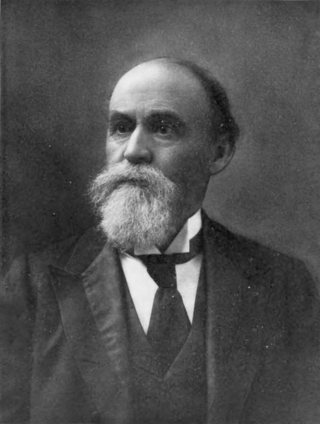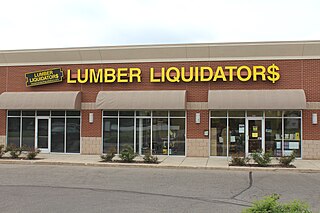
Meyer Township is a civil township of Menominee County in the U.S. state of Michigan. The population was 1,036 at the 2000 census. Hermansville is an unincorporated village within the township, and is where most of the population is concentrated.

The Guardian Building is a landmark skyscraper in the United States, located at 500 Griswold Street in Downtown Detroit, Michigan, within the Financial District. The Guardian is a class-A office building owned by Wayne County, Michigan and serves as its headquarters. Built in 1928 and finished in 1929, the building was originally called the Union Trust Building and is a bold example of Art Deco architecture, including art moderne designs. At the top of the Guardian Building's spire is a large U.S. flag, complementing the four smaller flags atop nearby 150 West Jefferson. The building has undergone recent award-winning renovations. It was designated a National Historic Landmark on June 29, 1989, and the associated Detroit Financial District is on the National Register of Historic Places. The Guardian building includes retail and a tourist gift shop.

Ally Detroit Center, formerly One Detroit Center, is a skyscraper and class-A office building located in Downtown Detroit, overlooking the Detroit Financial District. Rising 619 feet (189 m), the 43-story tower is the tallest office building in Michigan and the second tallest building overall in the state behind the central hotel tower of the Renaissance Center, located a few blocks away. Although the Penobscot Building has more floors above ground (45), those of Ally Detroit Center are taller, with its roof sitting roughly 60 feet (18 m) taller than that of the Penobscot. It has a floor area of 1,674,708 sq ft (155,585.5 m2).

This is a list of the National Register of Historic Places listings in Menominee County, Michigan.

The Qube, previously known as the Chase Tower, the Bank One Center, and the National Bank of Detroit Building, is a high-rise office building and Quicken Loans operations center in the U.S. designated Detroit Financial District at 611 Woodward Avenue, in Downtown Detroit, Michigan. It was built in 1959 and stands at 14 floors in height. It was completely remodeled in 2011 and is currently in the process of remodeling again. It was designed in the modern architectural style, and uses a great deal of marble to coordinate with the buildings in the nearby Civic Center. It was designed by Albert Kahn Associates.
The Babcock Lumber Company was founded in Pittsburgh, Pennsylvania in 1887 and conducted logging operations in the eastern United States. In 1951 the company diversified into building material distribution. Today the company has two main divisions: hardwood lumber manufacturing and wholesale building material distribution.
Pequaming is an unincorporated community in L'Anse Township of Baraga County in the U.S. state of Michigan. It is located on a narrow point of land that juts into Keweenaw Bay. Although still partially inhabited, Pequaming is one of the largest ghost towns in the Upper Peninsula of Michigan.

Chassell is an unincorporated community in Chassell Township of Houghton County in the Upper Peninsula of the US state of Michigan. It is located on Pike Bay at the south end of Portage Lake 47°01′42″N88°31′30″W and is the largest community in the township.

Orrin Williams Robinson was a politician and businessman from the U.S. state of Michigan. He ran a successful logging operation in the Upper Peninsula and was elected to serve in both houses of the Michigan Legislature and two terms as the 31st lieutenant governor of Michigan, from 1899 to 1903 under Governors Hazen S. Pingree and Aaron T. Bliss.

Savoyard Centre (1900), also known as State Savings Bank, is an office building at 151 West Fort Street in Downtown Detroit, Michigan. It was designated as a Michigan State Historic Site in 1981 and listed on the National Register of Historic Places in 1982. Another historic marker erected November 13, 1964, also notes that the site was previously occupied by Fort Lernoult until July 11, 1796, when, in compliance with the terms of the Treaty of Paris ending the American Revolutionary War, British troops had evacuated their last post in United States territory.

The Meadow River Lumber Company, which operated in Rainelle, West Virginia from 1906 to 1975, was the largest hardwood sawmill in the world. It had three 9 feet (2.7 m) bandsaws under one roof. In 1928, during peak production, its 500 employees produced 31 million board feet of lumber, cutting 3,000 acres (12 km2) of virgin timber a year.

Laona is an unincorporated census-designated place in the town of Laona in Forest County, Wisconsin, United States. U.S. Route 8 travels east–west through the community and Wisconsin Highway 32 travels south and west of the community. The community park has a sign stating that the community donated the 1979 Christmas tree at the nation's capitol. As of the 2010 census, its population is 583.

Hermansville is an unincorporated community and census-designated place (CDP) in Meyer Township of Menominee County in the U.S. state of Michigan. It formed around the defunct Wisconsin Land & Lumber Company as a company town. The company's former headquarters is open as the IXL Historical Museum. US Highway 2 (US 2) passes through the north edge of the community.

The First Congregational Church is located at 53248 N Avenue in the Linden Lake Historic District in Lake Linden, Michigan. It was listed on the National Register of Historic Places in 1980, and is significant for its impeccable architectural integrity.

Graf Brothers Flooring and Lumber specializes in, and is the world's largest manufacturer of, rift and quarter sawn oak products. Rift & Quartered lumber results from a unique way of sawing that maximizes the yield of lumber with vertical grain. Vertical grain is preferred because of its excellent technical properties. Lumber that has been sawed using this method expands evenly and vertically. Vertical grain also increases the structural integrity of the wood.
Goodwin Heart Pine is a company located in Micanopy, Florida and specializes in reclaiming antique heart pine and heart cypress from rivers and old buildings to produce lumber for flooring, stair parts and millwork. Goodwin's product range also includes other sustainable and rare woods, including wild black cherry. Goodwin Heart Pine also produces precision-engineered wood flooring, from these specialty woods. The company has a unique focus of harvesting resin-saturated deadhead logs from rivers that loggers felled in the 1800s, which sank due to their high resin content. The interior of the reclaimed logs is typically preserved by the tree's resin.

LL Flooring is an American retailer of hard-surface flooring including hardwood flooring, laminate flooring, vinyl plank flooring, tile flooring, bamboo flooring and cork flooring, as well as flooring tools and accessories.

The Cobbs and Mitchell Building is an office building located at 100 East Chapin Street in Cadillac, Michigan. It was designated a Michigan State Historic Site in 1980. and listed on the National Register of Historic Places in 2010.






















